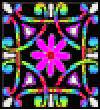These are eight symbols Swastika, Shrivasta (an auspicious sign on the chest), Nandhyavarta (complex swastika), Vardhamanaka, Bhadrasana (a holy seat), Kalasha (Holy pitcher), Minyugala (Fish-couple) and Darpana (Mirror), That have been auspicious since time immemorial and have been depicted in the Kalpasutra. According to the scriptures every Jain has to draw them with pure un-broken rice-grains before the icon of the Tirthankar. Some have reduced this custom to the drawing of a swastika, along with three heaps of rice-grain symbolising knowledge, vision and character.
- Swastika: symbolizes four destinies; a) human beings, b) heavenly beings, c) hellsih beings and d) tiryanchs (rest of the living beings). The root of Swastika is SU+US; SU means benefic and US means existence; so it also represents glory, prosperity, progress and success.
Swastik
- Shrivatsa: 'Vatsa' means chest and 'Shri' means beauty. The middle of the chest is raised a little with a bunch of soft hair. This is called Shrivatsa. Shrivatsa means a beautiful mark on manifested itself from the heart of the Jina.
Shrivatsa
- Nandyavart: big swastika with nine corners. In mythology nine points in nandhyavarta indicate nine types of material, mental, physical and spiritual wealth and treasure.
Nandhyavarta
- Vardhamanak: also known as sharav, which means a shallow earthen dish used for lamps. When one shallow dish is covered by another one upside down, it appears like a box. This symbol is suggestive of increase of wealth, fame and merit due to the grace of the Lord Jina.
Vardhamanaka
- Bhadrasana: (Sinhasana) meaning throne. It is auspicious because it is sanctified by the feet of the blessed Lord Jina.
Bhadrasana
- Kalash: Symbol of auspiciousness. It is a holy pitcher or a jug made of copper, silver or steel. It is used for religious and social ceremonies. It is used in temples when certain images are being worshipped. When one enters a new home it is customary to carry the kalasha on the head reciting mantras. The kalasha is filled with pure water, which signifies wisdom and fullness. This ceremony is performed to welcome grace and happiness into the new home.
Kalasha
- Minyugal: A pair of fish. It is a symbol of Cupid's banners coming to worship the Jina after the defeat of the God of Love.
Minyugala
- Darpan: Meaning a mirror. The mirror reflects one's true self because of its clarity.
Darpana
** Visit: http://jainismSansar.blogspot.com for more or like www.fb.com/jainismSansar or G+ profile https://plus.google.com/102175120666184498438/ **









A good vaastu hi lite for ones well beingvn devlopment
जवाब देंहटाएंA good vaastu hi lite for ones well beingvn devlopment
जवाब देंहटाएंA good vaastu hi lite for ones well beingvn devlopment
जवाब देंहटाएं